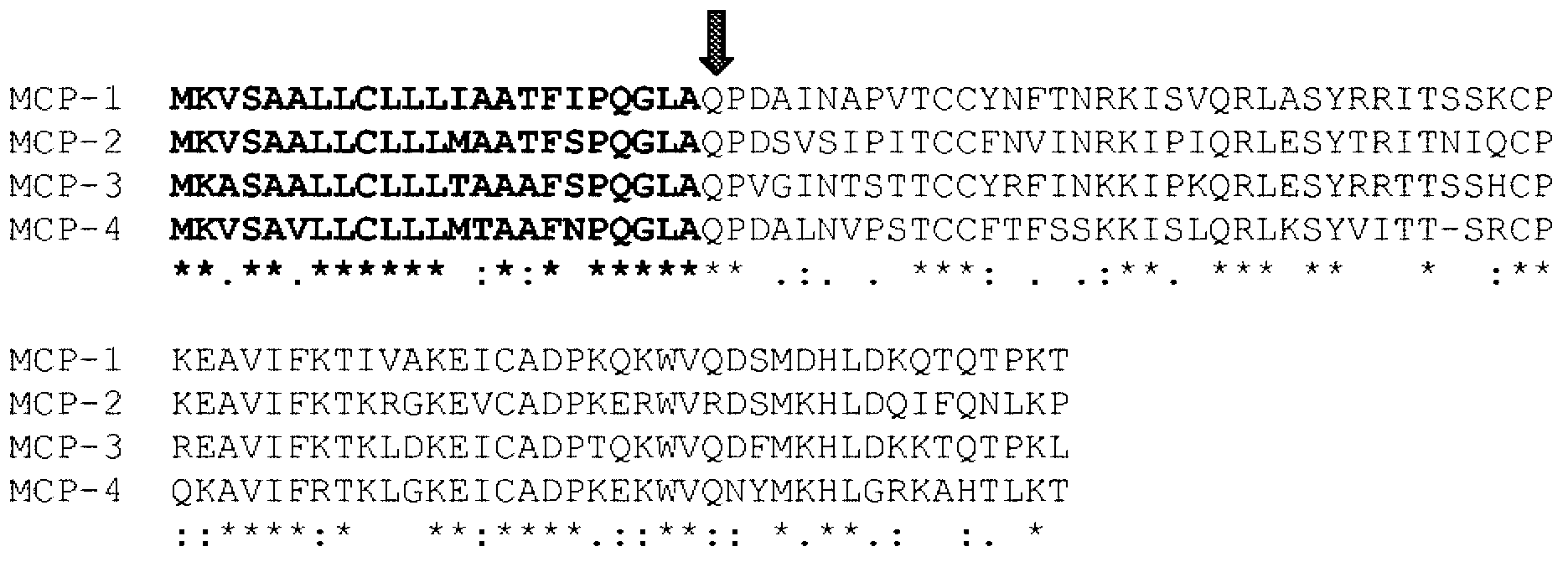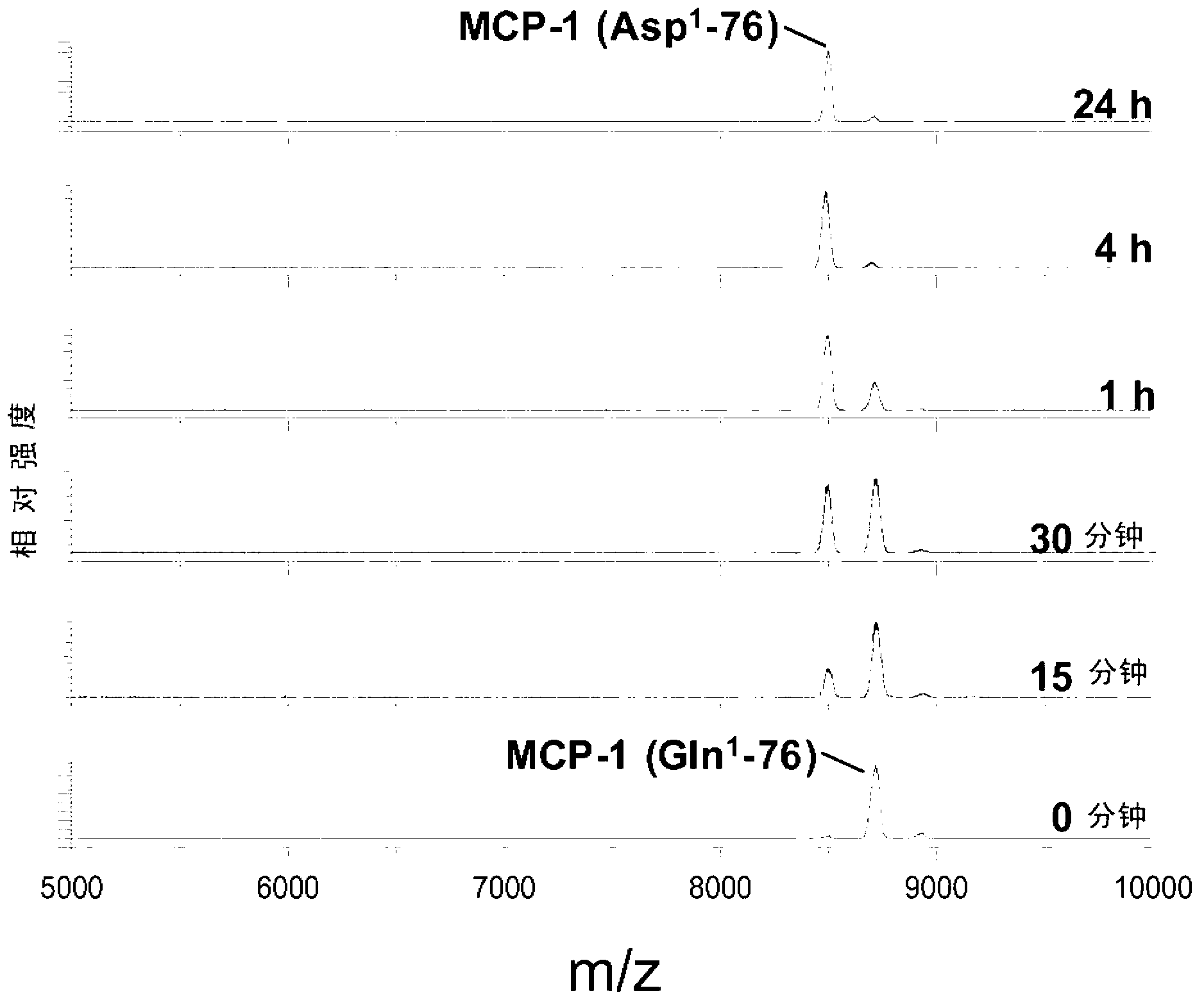Methods of diagnosing inflammatory diseases by determining pyroglutamate-modified mcp-1 and screening methods for inhibitors of glutaminyl cyclase
A technology of glutaminyl cyclase and MCP-1, which is applied in the fields of disease diagnosis, instrumentation, biological material analysis, etc.
- Summary
- Abstract
- Description
- Claims
- Application Information
AI Technical Summary
Problems solved by technology
Method used
Image
Examples
Embodiment 1
[0279] Embodiment 1: MALDI-TOF mass spectrometry
[0280] Matrix-assisted laser desorption / ionization mass spectrometry was performed using a Voyager De-Pro (Applied Biosystems, Darmstadt) equipped with a linear time-of-flight analyzer. The instrument is equipped with a 337nm nitrogen laser, a potential acceleration source and a 1.4m flying test tube. Detector operation is positive ion mode. Samples (5 μl) were mixed with an equal volume of matrix solution. For the matrix solution, sinapinic acid was used, which was prepared by dissolving 20 mg sinapinic acid (Sigma-Aldrich) in 1 ml acetonitrile / 0.1% TFA in water (1 / 1, v / v). Transfer a small volume (≈1 μl) of matrix-analyte mixture to the probe tip.
[0281] Test Glu for the long term 1 For cyclization, the MCP-1 peptide was incubated at 30° C. in 100 μl of 0.1 M sodium acetate buffer, pH 5.2 or 0.1 M Bis-Tris buffer, pH 6.5. Peptides were administered at a concentration of 0.15mM to 0.5mM and 0.2U QC was added. At vario...
Embodiment 2
[0282] Example 2: Proteolysis of human MCP-1(1-76) by dipeptidyl peptidase 4 (DP4), aminopeptidase P and proteases present in human serum
[0283] N-terminus of MCP-1 by recombinant human DP4 in the presence and absence of QC-specific inhibitors terminal degradation
[0284] Recombinant human MCP-1 starting with N-terminal glutamine (1-76) (SEQ ID NO: 1) (Peprotech) was dissolved in 25 mM Tris / HCl pH 7.6 at a concentration of 10 μg / ml. The MCP-1 solution was pre-incubated with recombinant human QC (0.0006 mg / ml) at 30°C for 3 hours, followed by incubation with recombinant human DP4 (0.0012 mg / ml) at 30°C, or with DP4 without prior addition of QC. In addition, Gln 1 -Incubation of MCP-1 with recombinant human QC in the presence of 1-(3-(1H-imidazol-1-yl)propyl)-3-(3,4-dimethoxyphenyl)thiourea hydrochloride conduct. The resulting DP4 cleavage products were analyzed by Maldi-TOF mass spectrometry after 0 min, 15 min, 30 min, 1 h, 2 h and 4 h.
[0285] N-terminal degrad...
Embodiment 3
[0290] Example 3: Degradation of Human MCP-2, MCP-3 and MCP-4
[0291] N-terminal degradation of human MCP-2 by DP4
[0292] Human recombinant MCP-2 (Peprotech) carrying an N-terminal glutaminyl rather than pyroglutamyl residue was dissolved in 25 mM Tris / HCl, pH 7.6 at a concentration of 10 μg / ml. MCP-2 was pre-incubated with recombinant human QC (0.0006mg / ml) at 30°C for 3 hours, then incubated with recombinant human DP4 (0.0012mg / ml) at 30°C or not pre-incubated with QC but with recombinant human DP4 (0.0012mg / ml) insulation. The resulting DP4 cleavage products were analyzed by Maldi-TOF mass spectrometry after 0 min, 15 min, 30 min, 1 h, 2 h, 4 h and 24 h.
[0293] N-terminal degradation of human MCP-3 by DP4
[0294] Human recombinant MCP-3 (SEQ ID NO: 12) (Peprotech) carrying an N-terminal glutaminyl rather than pyroglutamyl residue was dissolved in 25 mM Tris / HCl, pH 7.6 at a concentration of 10 μg / ml. MCP-3 was pre-incubated with recombinant human QC (0.0006mg...
PUM
 Login to View More
Login to View More Abstract
Description
Claims
Application Information
 Login to View More
Login to View More - R&D
- Intellectual Property
- Life Sciences
- Materials
- Tech Scout
- Unparalleled Data Quality
- Higher Quality Content
- 60% Fewer Hallucinations
Browse by: Latest US Patents, China's latest patents, Technical Efficacy Thesaurus, Application Domain, Technology Topic, Popular Technical Reports.
© 2025 PatSnap. All rights reserved.Legal|Privacy policy|Modern Slavery Act Transparency Statement|Sitemap|About US| Contact US: help@patsnap.com



